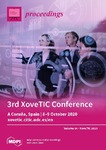CultUnity3D: a Virtual Spatial Ecosystem for Digital Engagement with Cultural Heritage Sites

Use este enlace para citar
http://hdl.handle.net/2183/26378Colecciones
- Investigación (FSOC) [405]
Metadatos
Mostrar el registro completo del ítemTítulo
CultUnity3D: a Virtual Spatial Ecosystem for Digital Engagement with Cultural Heritage SitesFecha
2020Cita bibliográfica
Salas, E.L.; García, A.X.; Gómez, Á.; Dafonte, C. CultUnity3D: A Virtual Spatial Ecosystem for Digital Engagement with Cultural Heritage Sites. Proceedings 2020, 54, 27. https://doi.org/10.3390/proceedings2020054027
Resumen
[Abstract] In order to help enhance public outreach and understanding of historical sites, we developed a virtual spatial ecosystem called CultUnity3D. It consists of a set of components specifically implemented within the Unity engine that enable the user to virtually explore spatial changes over time in two different modes, and to learn about the past of a built environment through the integration of and interaction with research sources and narrative. Although we built CultUnity3D for a particular case study, which is the monastic site of San Julián de Samos (Spain), this in-progress virtual ecosystem has been thought out and designed for continued and reusable development.
Palabras clave
Virtual reality
3D modeling
Unity
Spatiotemporal simulation
Digital art and architectural history
3D modeling
Unity
Spatiotemporal simulation
Digital art and architectural history
Versión del editor
Derechos
Atribución 4.0 Internacional
ISSN
2504-3900






